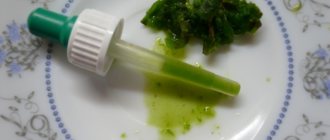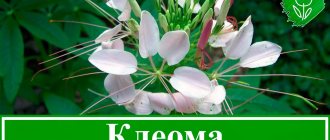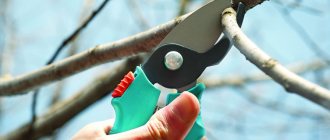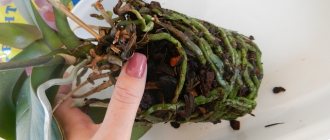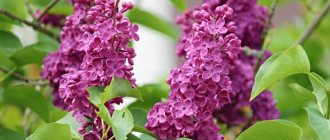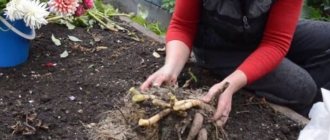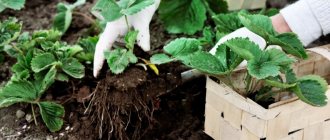Some indoor plants require unusual care and the creation of certain conditions. For example, the familiar Kalanchoe fades after flowering, and what to do in this case to return the bush to its former decorative appearance.
It’s rare that anyone can remain indifferent when passing by a flower shop with Kalanchoe bushes on display. The lush caps of inflorescences amaze with their magnificence and variety of colors - milky white, foamy pink, crimson, orange, bright red... Of course, it is impossible to resist buying this living joy! But, I think, many are already familiar with the situation when, after a lush and prolonged flowering, a bush begins to lose its decorativeness and attractiveness.
First, the inflorescences wither, then thin branches stretch out, the leaves become smaller, the stem becomes bare and becomes woody. In this form, the plant can hardly be called a window sill decoration. What to do? In such a situation, some simply throw away the faded specimen and forget about it.
Lush caps of inflorescences amaze with their splendor and variety of colors
Others intensify their care and rush to save the bush with all their might: they intensively fertilize it, replant it in a new pot, place it closer to the sun or vice versa, put it in the shade. But, as a rule, all these activities do not bring visible results.
I hasten to reassure you, this “behavior” of Kalanchoe is not at all bad care or inappropriate conditions of detention. It’s just that for an aesthetic appearance, the bush needs constant rejuvenation - be it heavy pruning or rooting cuttings. But for lush, long-lasting, and even repeated growth, you need a certain light regime, compliance with certain watering features and a fertilizer application schedule.
Therefore, if you decide to master the successful technology of growing indoor Kalanchoe, it is worth getting to know it better.
Video about growing Kalanchoe at home
Growing conditions and care
It must be said right away that modern varieties differ significantly from the plants we are familiar with from childhood. Remember, the Kalanchoe that grew on my grandmother’s windowsill was much taller and more spreading than its store-bought counterparts. He was distinguished by his unpretentiousness and tolerance, without any particular offense towards the owner’s forgetfulness in watering and replanting, and caused a minimum of trouble.
But its flowering was quite modest: small, scattered and quickly falling flowers, unfriendly buds blooming. Against their background, the luxurious inflorescences of modern Dutch hybrids are simply enchanting!
But not many people know that such varieties were bred for street decoration. They were used to decorate flower beds, flowerpots with flowering bushes were displayed on open terraces and balconies, and they were used to decorate the entrance to the house and recreation areas. So, based on the selective characteristics of these hybrids, it is most logical to throw away the Kalanchoe after it has flowered, but not everyone will raise their hand to do this. In this case, we will independently restore, propagate and grow compact flowering bushes.
Basic conditions of detention:
- The soil. It should be quite loose and nutritious. The best option would be the top layer of soil from the forest, but ordinary garden soil with the addition of humus or compost will do and further care will not be necessary without regular fertilization.
- Lighting. Kalanchoe is a tropical plant, which means that direct sunlight does not burn it, the light must be intense, but diffused. A similar regime in an apartment can be created by placing the pot on the south-east, south-west window sill or near the south window in light shade from the curtain. To stimulate flowering, the plant needs to artificially organize a short daylight hours, lasting no more than 8-10 hours.
- Fertilizers. Considering that a compact bush grows for about a year and a half before it requires rejuvenation, the nutrition contained in the soil is sufficient for it. Additional organic fertilizers (humate, herbal infusions, peat) are usually applied only during the flowering period. At the same time, it is necessary to strictly limit the supply of nitrogen components, after which a lush growth of greenery may occur instead of flowering, so no selitol, ammonia and urea. When buying ready-made nutrient concentrates, choose those designed for fertilizing cacti or succulents.
- Rest. Plants need a period of rest to prepare and gather strength for future flowering. At this time, care consists of limiting watering, changing the light intensity and lowering the air temperature. Typically, it is recommended to take rest at the end of winter - beginning of spring.
- Rejuvenation. You can maintain the decorative appearance of the bush by regular pruning, while the cut cuttings are rooted in water or wet sand, and then planted in a separate pot, obtaining a new, young plant. And in order for the remaining stump of the old bush to produce new shoots faster, it needs to be transplanted into new soil and covered with a transparent bag or glass jar.
- Watering. Kalanchoe, like most succulents, does not tolerate high soil moisture, leading to rotting of the roots and even death of the plant, but at the same time, drying out of the earthen coma can negatively affect flowering. Therefore, drainage holes must be made in the bottom of the new pot. Special care and caution in watering are needed in winter, and in summer, water only after the top layer of soil has dried.
Important! To prevent the development of fungal infections and putrefactive processes in the soil, it is enough to place several charcoals on the bottom of the pot during replanting, and add wood ash to the soil mixture.
Video about caring for Kalanchoe
Agree, advice from experienced flower growers can be a good help to many rules and requirements. Sometimes, through trial and error, excellent results are achieved, so it is worth listening to proven recommendations and incorporating them into your care.
- Tip #1. In May, when the Kalanchoe bush has already bloomed, I cut off all the cuttings, stick each of them into separate pots with ordinary garden soil and cover them with transparent jars. Most of the petioles quickly take root and soon young leaves appear on them. By autumn you will already have lush bushes that will bloom by November. And in April they will bloom a second time, after which we will repeat everything all over again - cut off the cuttings, plant them, and throw away the old ones.
- Tip #2. Reducing daylight hours is not that difficult. Just in October or March, at about 5 o’clock in the evening, cover the flower along with the pot with an opaque cap (a dark bucket, box or even a pan), and in the morning at 7 o’clock be sure to remove the cover. Such care with darkening will lead to the appearance of flower buds within a month.
- Tip #3. You can rejuvenate a plant without rooting. First, after flowering, all faded flower stalks are cut off. When you notice that the shoots have begun to grow, pinch them, and a little later, break off those growing from this place after the third pair of leaves, and so on, until a branched but dense bush is formed. The last pinching is done in October, since further stimulation of the formation of flower buds is carried out.
- Tip #4. Different varieties of Kalanchoe look amazingly beautiful and original when they are planted in one pot - the inflorescences form a bright, variegated, multi-colored cap.
Experiment when planting, because it won’t make it any more difficult, and the result will be great!
Pruning Kalanchoe plays an important role in succulent care; it is especially necessary to create decorative appearance for the bushes and provide the necessary conditions for the formation of flower stalks.
To many, the pruning procedure seems harsh and blasphemous. There are many people among flower growers who feel sorry for hurting their beloved plant. After all, it is a living organism that only cannot speak, but just like people, it breathes, eats, and, judging by some scientific studies, even meets its owner, the person who cares for it, with different moods.
However, in the case of Kalanchoe, emotions and lyrics should be cast aside, because without pruning the plant loses its decorative appearance, the pagons become bare from below, losing old leaves, bend anywhere, bend, and during flowering they become covered with thin, few inflorescences. Pruning Kalanchoe is an important element of care that is not subject to doubts or objections, and any owner of a succulent should learn to do it correctly and at the proper time in the plant’s life cycle.
Optimal conditions for growing Kalanchoe
Kalanchoe is an undemanding plant and grows well in apartment conditions. In winter, the plant tolerates direct sunlight well. You can place the pot on a south, east or west window. In summer, the rays of the scorching sun can burn the leaf plates, which will affect the growth process of the flower, so it is better to shade the pot.
The northern window is not suitable for growing Kalanchoe; due to lack of light, the shoots stretch out, flowering is very sparse or absent altogether.
Did you know? Kalanchoe is not only a beautiful ornamental plant, for example, Kalanchoe Degremona is medicinal, its leaves and shoots are highly valued in folk medicine.
The temperature range at which the plant feels comfortable is quite wide - from +15 to +29 °C, which allows you to grow Kalanchoe at home at any time of the year without any problems.
However, at temperatures below +10 degrees, the flower may stop developing and begin to hurt, so it is not recommended to place the pot near an air conditioner or on a cold windowsill in winter.
Air humidity should be average - from 50 to 70%; at low humidity the plant may get sick. Also, dry air is a habitat for pests, so it is recommended to spray the plant regularly or install a container with wet expanded clay next to the pot.
Kalanchoe prefers soil with an acidity level of 5 to 6.5 pH.
How and when to prune
There are several types of pruning: initial, preventive and after flowering. Each of them is produced at a certain period of the life cycle, corresponding to the time of year.
Initial pruning is carried out on young plants immediately after transplantation in the spring. For older specimens, the branches are shortened throughout the entire growing season - preventive pruning is carried out. During flowering and the dormant period, no manipulations are performed to form the crown, but immediately after the last corollas wither, the flower stalks are removed. The exception is diseased or pest-affected tops of the runners or individual leaves, which are removed even during the plant's rest period.
How to properly prune Kalanchoe at home
Not all succulents take pruning painlessly. Delicate white- and yellow-flowering varieties of Kalanchoe Blossfeld take a long time to fade after manipulations with shortening of shoots, and some wither until they die. When pruning a plant, you need to understand a sense of proportion and not cut up shoots with leaves at random, breaking them off with your hands or cutting them off near the root itself.
The tool used for pruning is also important - it must be sharp and disinfected, and if there is a need to carry out the procedure on several succulents, it must be disinfected after each plant, moving from one to another.
It is advisable to shorten the stems of Kalanchoe in the morning, so that by the evening, when the air temperature in the room begins to drop at night, the cuts will already have time to dry out and tighten.
Short description
In total, about two hundred varieties of this plant are known for growing at home. Each of which has its own characteristics, and, accordingly, you need to take care of it after studying the information. Kalanchoe is no exception.
In principle, the plant is unpretentious, but some points simply need to be known and monitored in order to subsequently enjoy magnificent flowering and lush greenery.
- Kalanchoe belongs to the Crassulaceae family, this plant is a succulent. Its leaves are bright green in color, fleshy in structure, with a shiny glossy surface.
- Flowering is expressed by apical lush inflorescences of various colors. Depending on the variety, the flowers have the structure of a bell, an elongated tube, or a double inflorescence with many petals.
- The shrub reaches a height of approximately 40 cm, but there are varieties that grow up to one meter. Recently, “gift” dwarf options have also appeared.
- In addition to being decorative, the flower has medicinal properties that have been known in folk medicine for more than 200 years. The juice of the plant really helps with colds and runny nose. Therefore, Kalanchoe is grown not only for beauty, but also for benefit.
- The most famous varieties of indoor varieties are Kalanchoe Blossfeld and Degremona.
- With good care, the plant can bloom almost all year round. It is enough that the air temperature in the room does not fall below 10 degrees Celsius, that the soil in the pot is constantly moderately moist, and that the direct scorching rays of the sun do not fall on the flower.
A separate column in the care rules is pruning. Let's study this issue in more detail.
Initial trimming
It is carried out in the spring after transplanting young plants into another, more spacious flower container. The fact that Kalanchoe has taken root will become clear by the formation of new leaves at the tops of the shoots. The top two of them should be cut off on each branch. It is necessary to observe the open wounds - if they dry out within 3-4 hours, it means that the plant is successfully coping with the pruning procedure on its own. Otherwise, the cuts are crushed with charcoal powder or cinnamon.
Preventative pruning
Produced throughout the growing season. Young branches that have grown from a cut or from the axils of lower leaves are pruned and have formed three pairs of leaves. A similar procedure must be repeated with the next batch of newly grown shoots, and so on until a compact and beautiful bush shape is obtained.
With the arrival of autumn, they stop cutting off the tops of the plants' branches. During this period, the succulent, and all attention must be focused on observing a period of short daylight hours, so that the plant's flower buds actively begin to grow, forming flower stalks with buds.
Types of Kalanchoe with photos and names
The genus Kalanchoe consists of about 20 species, many of which are grown at home. The most common:
Kalanchoe Bryophyllum Bryophyllum
Kalanchoe Bryophyllum Bryophyllum photo
It is known for its many flowers, collected in the form of an open umbrella, rising on a long peduncle. Flowering colors are varied.
Kalanchoe blossfeldiana
Kalanchoe blossfeldiana photo
A dwarf, abundantly flowering species with stunningly beautiful decorative flowers of a wide variety of shapes and colors.
Kalanchoe Kalandiva
Kalanchoe calandiva flowering photo
Small, blooms for about six months, bred through selection.
Kalanchoe manginii
Kalanchoe manginii photo
Grows up to 15 cm tall, with original flowers that look like small bells.
Kalanchoe daigremontiana
Kalanchoe daigremontiana photo
Up to 10 cm high, with a straight stem and green triangular leaves, does not bloom.
Kalanchoe pinnate Bryophyllum pinnatum
Kalanchoe pinnate Bryophyllum pinnatum photo
The most hardy species, the flowers are white, gradually turning into green. This type of juice is sold in pharmacies.
With a minimum of effort, you will get a beautiful plant with beneficial properties.
How to prune Kalanchoe after flowering
After making sure that the last corolla has withered, the flower stalks are cut off at the very base. It is not advisable to leave them on the bush for some time. Firstly, they completely spoil the appearance, and secondly, they begin to die, dry out, rot and become a source of infection on the plant. Consequently, in order not to reach such a moment, the flowering stems are removed in a timely manner.
Many flower growers carry out drastic pruning at this time, removing all the pagons on the bush by one third of the length. This is followed by a period of rest, lasting at least a month and a half, and then the growing season begins, and the pruned branches soon give rise to new regrown stems, covered with lush green foliage.
It should be noted that during dormancy on the bush, the lower leaves often die off, exposing the base of the stems. This is a natural process; old leaves also need to be removed; in their place, new pagons grow from dormant buds in the axils thanks to the trimmings.
How to pinch Kalanchoe: differences from pruning
Pinching differs from pruning in a more gentle way of carrying out manipulation and is carried out primarily on plants of those varieties that react painfully to pruning.
After removing the succulents from the dormant period, the last two leaves are plucked off at each top of the pagons. As soon as new branches grow from the axils of the leaves and when they form three pairs of leaves, the next pair - the fourth - is pinched again. You can repeat these steps until November, and then begin to prepare the Kalanchoe for flowering, adjusting the number of hours spent under bright light.
Let's sum it up
Any type of Kalanchoe can be pruned and pinched, it’s just that the reaction of different plants is different: some recover immediately from “surgical” interventions and grow back quickly, while some “shine” with stumps for a long time and only after some time are covered with a new dense crown. However, pruning is an integral element of Kalanchoe care, and due attention must be given to it.
Pruning Kalanchoe. Kalanchoe stretched out. Rules for care and pruning. Read how to achieve lush flowering by pruning Kalanchoe?
Stretched Kalanchoe
- the result of lack of pruning. Let's consider updating the crown as an opportunity to restore the flower, without considering other possible violations.
Why prune Kalanchoe briefly:
Before you start pruning your Kalanchoe if it is stretched, refer to the recommendations for your species. Although there are about two hundred species of Kalanchoe, each has its own procedural preferences and may not like pruning.
Please note: hybrid species of Kalanchoe, especially those with yellow inflorescences, do not tolerate pruning well.
Popular species – Kalandia, Blossfelda
– they take well to the annual renewal of the crown, thanks to which it is possible to form a beautiful, healthy bush in a compact pot.
How to set the direction of growth: a) pinch the side shoots to develop the Kalanchoe and sew it in, b) remove the top or individual shoots to grow the Kalanchoe and create a rounded shape.
Preparing for pruning Kalanchoe
Before the procedure, preparations are carried out:
water a couple of days before pruning, but do not add water on the day of the procedure, disinfect tools, prepare powdered charcoal or fungicide.
How to prune Kalanchoe?
Remove shoots only with tools - pruning shears, sharp scissors or a knife - and close the wounds. Do not process more than the required length for renewal, so as not to stress the Kalanchoe.
How to prune Kalanchoe if it is stretched:
- Remove up to 2 elongated leaves on the stem.
- Go over the shape of the crown and remove the elongated leaves.
- Process to healthy weight.
- Sprinkle the wound with charcoal powder.
- Leave in a place without sudden fluctuations in lighting and temperature.
Kalanchoe care after pruning
Having treated the crown, it’s time to prepare the plant for restoration. Kalanchoe pruning is usually
, after which temperature indicators contribute to recovery.
If the plant has stretched out at the beginning of autumn, and you have done light pruning, reinforce the result with a temperature of +15 ° C.
Try not to prune close to the cold period. 1 month is enough for recovery.
How to care for Kalanchoe after pruning
: water moderately and regularly several times a week, but adjust the volume of moisture to the competitive period, add charcoal to the soil once a month, create suitable temperature and light and shadow conditions. In the latter option, place it on the eastern windows.
Criteria for pruning Kalanchoe:
- The shoots of the upper part are from 7 to 10 cm.
- Straight cuts.
- Minimal damage to the crown due to uneven cuts.
- Remove shoots evenly to distribute sap.
Trimming nuances:
- It is forbidden to cut off the top part of the Kalanchoe in the summer - the shoots are stretched and the structure of the crown is disrupted.
- Do not handle with dirty tools.
- Manual removal of shoots is contraindicated.
↓ Write in the comments how do you prune a Kalanchoe if it is stretched?
(No ratings yet, be the first)
Caring for the plant after pruning and pinching
Pruning shoots in any case causes damage to the upper part of the Kalanchoe. Following several step-by-step recommendations that are practically no different from everyday care will help you recover faster:
Care after pruning consists of moderate watering at the root
- Watering is carried out after the top layer of soil has dried: in the warm season once every 3-4 days, in the cold season - no more than once every 14 days;
- It’s better not to water once or twice than to flood the Kalanchoe. This culture is able to store a sufficient amount of moisture in the fleshy foliage, and then gradually consume it;
- water for irrigation should be soft and settled at room temperature;
- water the flower by pouring water under the root or into a tray under the pot, through which the rich root system of the plant will absorb the required amount of moisture;
- a few hours after watering, excess water is drained from the trays, which does not allow putrefactive processes to develop in the roots;
- The optimal period for feeding is the flowering of Kalanchoe, which allows you to extend the life of the blossoming inflorescences and plant new buds for the plant. It is enough to feed the plant once a month until the end of abundant flowering. Excess and frequency of fertilization provokes excessive growth of green mass and deformation of shoots, which negatively affects the decorative properties of the flower;
- Every year in the second half of March, Kalanchoe needs to be transplanted into a new container, 2-3 fingers larger in diameter than the previous one. When transplanting, the flower is removed along with a lump of earth, which minimizes the risk of damage to the roots.
Annual replanting of succulents should be carried out by transshipment together with an earthen lump
Note! The ideal soil mixture for Kalanchoe should consist of equal parts of turf, leaf soil, coarse sand and ½ part humus. When replanting, a new container is filled a quarter full with a drainage layer, for example, made of pebbles or expanded clay. The drainage voids are filled with soil mixture, after which the root system of the plant with a ball of earth is placed in the container.
Basic methods of plant formation
Pruning Kalanchoe primarily aims to give the bush a neat shape, and also creates more favorable conditions for development and growth for the flower. The juice accumulated inside the plant spreads evenly along the stems and foliage. As a result, the plant takes on a healthier, “juicier” appearance, and its resistance to diseases and attacks by insect pests increases.
The decorative purpose of pruning is also important. With the exception of a couple of species - pinnate and Degrimona - the flower is grown as a compact and attractive, lush and beautifully flowering plant. Almost all of its varieties are characterized by rapid growth of shoots. Pruning and pinching prevent the stems from branching chaotically and help form Kalanchoe with a neat round shape that is pleasing to the eye.
The purpose of the pruning and pinching procedures is:
Before pruning or pinching, you should accurately determine the variety of the crop - Kalandiva or the Blossfeld variety tolerate even intensive pruning, but rare hybrids that bloom in yellow, pink, and white are much more sensitive to it. An incorrectly carried out procedure can destroy them, so more often they are treated only by carefully pinching the top.
Trimming
This procedure comes in three types:
- initial - carried out immediately after the young plant has taken root and started to grow;
- preventive - helps to form a beautiful shape, and also contributes to the health of the flower by removing diseased and old shoots;
- after flowering - this frees the bush from withered peduncles, which become “provocateurs” of stem rotting. In addition, such pruning helps to obtain lush flowering next year.
When cutting a flower, simple but mandatory rules must be followed. They help even a novice gardener to carry out the procedure in the least painful way and with maximum benefit for the plant.
Pinching
The procedure means pinching off the ends of the flower shoots as they grow. This helps the bush grow densely and forms its neat shape.
The resulting cuttings after pinching are good for plant propagation - they quickly and easily take root in water or moist soil.
What you need to know before pinching
The heroes of our article belong to plants that have been used for medicinal purposes since ancient times.
The heroes of our article belong to plants that have been used for medicinal purposes since ancient times. Juice was squeezed out of their leaves, which had an anti-inflammatory effect, used on wounds, burns, and even against the “scourge of humanity” - the common cold (for which, until now, there are almost no more effective medicines). Especially after pinching, Kalanchoë grows quickly,
Although almost all varieties of Kalanchoë require pinching, there are certain species that do not need pinching - they already have a complete shape all year round, without the shoots that periodically dry out at the ends of other species. One of these is the most famous of all, among scientists and gardeners it is called Degremona, and among the people it received the honorary name “doctor” (or “surgeon”), for its exceptional medicinal properties. And also – “crocodile”, behind the fleshy jagged leaves growing in pairs, between which the “younger generation” huddles. Although this Kalanchoe withstands pinching firmly, and if desired, this can be done, after this procedure it grows side shoots without much zeal.
Video about Kalanchoe
Features of the pruning procedure
The rules for pruning Kalanchoe at home differ for different varieties. In particular, Kalanchoe Blossfeld (has bright red flowering) tolerates the removal of not only leaves, but also side shoots in any quantity. Even the bare “stump” of a flower will sprout new shoots and gradually become covered with young foliage. Kalandiva also “favorably” refers to radical pruning of Kalanchoe.
For work, use a sharp knife or scissors that have been previously disinfected with alcohol.
Pruning is done in the morning or evening to avoid direct sunlight hitting the plant. After the procedure, choose a place for the flower that is illuminated, but without direct exposure to solar ultraviolet radiation, so that the Kalanchoe does not begin to grow rapidly, losing its acquired shape.
Hybrid varieties, as indicated above, are not pruned. They just need to be pinched correctly.
Dates
The procedure of pruning and pinching is not carried out in late autumn and winter, when the flower “retires”. It is resumed at the end of spring, even before the Kalanchoe buds are laid.
Thus, formative and preventative pruning is carried out for the last time in November if the flower is on a windowsill near a south window, or a little later if it is located on a western or eastern window.
First and subsequent preventive pruning
The first pruning for a young Kalanchoe is carried out immediately after its growth begins: one or two upper leaves on each shoot are removed. Gradually, new shoots will appear in the pinched areas. Subsequently, 1-3 leaves are also cut off from them. From spring to late autumn, you can thus create a dense crown of an indoor flower with an attractive, neat shape.
If at the end of May the Kalanchoe still does not show signs of preparation for flowering, and is only “fatten”, increasing the green mass, remove 2-4 upper leaf plates on each shoot. This stimulates not only its growth in breadth, but also the laying of new flower stalks.
To prevent the development of rot, carefully inspect the plant and remove all damaged stems and leaf blades. In addition, without preventive pruning, Kalanchoe sheds its old lower leaves as it grows, exposing the trunk. Pinching the corresponding shoots will force them to branch, creating an even density of the bush.
Preventive pruning of Kalanchoe is also carried out only from spring until the end of autumn (maximum - the beginning of winter). After the first shaping procedure, the flower is not placed in the sun to avoid active growth of shoots.
How to prune Kalanchoe after flowering
This procedure is carried out only after flowering has completely finished. Its main goal is not only to maintain the shape of the Kalanchoe bush, but also to free it from flower stalks. There is no need to pull - it is important to prevent the petals from drying out and crumbling, and the flower stalks from withering. To prevent the plant from starting to rot, pinch them all and as close to their base as possible. This will stimulate the appearance of new stems ready for flowering next year. At the same time, you can “trim” the Kalanchoe bush, removing excess leaves. Work is carried out in the morning, reducing the lighting intensity.
Having completed pruning the Kalanchoe after flowering, you need to give the plant a rest for one to one and a half months, since the process of formation of buds and flowers greatly weakens it. During the “sleep period,” watering is reduced and placed in a dark, cool place. This is also important for abundant flowering in the coming season.
Subtleties of the procedure for different types
The molding methods described above are suitable for “ordinary” Kalanchoes that bloom with red flowers. For rare hybrids with white, yellow or pink flowering, they are too radical: active pinching can not only provoke a painful state of the flower, but also destroy it.
Hybrid varieties are pinched in a smaller volume, each time treating the remaining wounds on the stems with crushed activated carbon or wood ash.
How to form a Kalanchoe bush
Kalanchoe shoots (primarily we are talking about decorative flower varieties) reach a height of up to 50 cm, but the greatest decorative value is a dense, low bush without bare stems showing through between the leaves. To form such a bush, regular pruning is required from the first stages of the plant’s life. Kalanchoe pruning is carried out using the “pinching” technology - the tip of the shoot with two young leaves is cut off with a sharp knife or blade. It is not recommended to use scissors for this, since they compress the thickness of the fleshy stem, causing severe damage to it. The cuts quickly dry out and tighten. If rot begins to form on them, the affected surface should be treated with potassium permanganate or wood ash.
One of the advantages of Kalanchoe is quick and easy propagation by cuttings. All pruned shoots are suitable for producing daughter plants. If it was not possible to successfully form a bush, you can simply replace it by placing one of the cuttings in water for 1-2 weeks until the roots appear and planting the resulting plant instead of an unsuccessfully formed or too old one.
How to pinch Kalanchoe
The step-by-step procedure will help you carry it out correctly:
- as soon as the Kalanchoe shoots begin to grow, the top two leaves are plucked off;
- after two new shoots appear at the pinching site, they are allowed to grow until the third pair of leaves appears and at this level they are pinched again.
This is repeated constantly until a bush of the required shape is formed.
Too elongated, thinned shoots can be pinched more radically - with more leaves. Experienced gardeners carry out the procedure with their fingers, but for beginners it is more correct to pinch the plant with scissors or another disinfected sharp instrument. To prevent infection or bacteria, sections should be sprinkled with crushed activated carbon or dusted with ash.
Pinching Kalanchoe is not recommended until flowering is complete.
Competent and timely shaping will ensure rich and long flowering next season, make Kalanchoe a highly decorative and attractive flower, and strengthen its health and endurance.
Kalanchoe is a plant that can be seen in many apartments. And there is an explanation for this: almost all of its varieties are unpretentious and are capable of having a healing effect on the body. However, even the most picky flower needs. This includes fertilizing, loosening the soil, and pruning. Pruning is a simple process, but in order not to harm the flower, you need to know how to prune Kalanchoe, namely the sequence of the procedure and the best time for this.
Kalanchoe: how to care and prune to bloom
In favorable conditions, the flower develops quite quickly. If the shoots become elongated, the foliage becomes smaller, and eventually dries out at the tips, the plant does not have enough strength for the normal development of the entire green above-ground part, and accordingly, the flower will not be able to bloom against this background. This appearance of the Kalanchoe indicates that it is time to start pruning, following the following recommendations:
- the cutting tool must be well sharpened in order to quickly cut off unnecessary parts of the plant without causing tears or damage;
- the pruning tool is disinfected with an antiseptic before and after the procedure, which reduces the risk of the flower contracting an infection;
- Before the procedure, hands are thoroughly washed under running water and detergent;
- The greatest effect is achieved by pruning carried out in the morning;
- For weak, elongated shoots, pinching is enough; fading and yellowing shoots need to be cut at the root;
- the actively growing top of a young succulent is pinched, and that of an adult bush is cut off with a knife;
- the cut areas are sprinkled with a thin layer of charcoal or activated carbon, crushed into powder;
- after pruning, the plant is provided with partial shade, since moderate light and heat stimulate the active growth of green mass.
What is pruning Kalanchoe at home and why is it needed?
Pruning Kalanchoe is the removal of excess leaves or flower stalks. It is necessary to give the flower a neat round shape. Growing in the form of a small bush, the plant looks more original than a long thin stem stretching upward with chaotic branches.
In addition to decorative purposes, pruning Kalanchoe at home is necessary to create the most favorable conditions for the life of the plant. The accumulated juice inside the flower is distributed evenly among the shoots, filling the leaves. The plant becomes succulent and more resistant to drying out and wilting.
There are three types of pruning Kalanchoe:
- initial;
- preventive;
- after flowering.
To trim the flower, it is better to use a sharp table knife or a stationery blade. Pulling off leaves by hand can harm the plant and cause it to wilt.
The need and types of pruning Kalanchoe
During pruning, peduncles or excess leaves are removed from Kalanchoe. This allows you to give the plant a rounded shape. After all, a small bush looks more attractive than a long bare stem with randomly located shoots. In addition, pruning helps create favorable conditions for the flower - the juice accumulated inside the plant is directed to all shoots and leaves, filling them. As a result, Kalanchoe becomes more resistant to wilting and drying out.
Trimming Kalanchoe is not at all difficult.
There are three types of pruning:
- initial;
- preventive;
- after flowering.
Each of these types of bush formation has its own purpose and its own rules.
How to prune Kalanchoe depending on the type of flower
Depending on the type, the pruning rules differ. Today, more than 200 varieties of the plant are known, however, only a few can grow at home. The most common variety is Blossfeld, which blooms with bright red flowers. Trimming its excess leaves can be done in unlimited quantities. Even if you cut off all the adventitious branches and leaves, leaving only a “stump,” this flower will again be covered with thick leaves after a while.
The situation is more complicated with varieties of Kalanchoe that bloom with white and yellow flowers. Such varieties are quite rare and whimsical. Excessive removal of leaves can have detrimental consequences for the plant. Before pinching rare species of Kalanchoe, it is necessary to accurately determine its variety.
As a rule, proper pruning of Kalanchoe occurs painlessly for the flower. However, if a wound forms on the stem in the form of rotting, it is necessary to sprinkle the area with a small amount of wood ash.
Planting and care in the garden
Few people know that Kalanchoe can be kept not only indoors, but also in the garden. However, growing (reproduction) at home is much easier than in the open ground.
How to care for a Kalanchoe flower in the open ground? The plant cannot withstand temperatures below zero . The soil must be neutral or slightly acidic in composition with a nutrient layer thickness of at least 12 cm.
The seedlings must have a height of at least 10–12 cm and about 6 developed leaves. Before planting, you should fertilize the area with rotted manure, superphosphate and potassium salt.
After engraftment fertilizing in the form of nitrogen fertilizers in July and August The distance between plants is approximately 30 cm, and the row spacing is 50 cm.
Before flowering, you need to loosen the soil at least 5 - 6 times.
What to do if it doesn't grow?
In such a situation, the owner should make sure that he follows all recommendations for caring for Kalanchoe .
It is also possible that Kalanchoe does not grow due to existing diseases and pests.
They get rid of diseases and pests by pruning the affected areas and treating them with insecticides.
Initial and preventive pruning
A young plant must be pinched almost immediately as soon as it has taken root and begins to grow. On each shoot of Kalanchoe it is necessary to cut off one or two top leaves. This is the initial trimming of the flower. Further, as necessary, preventive pruning will take place: new shoots will appear at the site of splitting off, on which leaves will form. This procedure must be repeated until the plant takes on a neat round or bushy shape.
If you have any questions, you can watch a video on how to prune Kalanchoe at any stage of its growth.
In winter, in particular after November, it is advisable to stop pruning. It will be possible to resume the procedure in late spring, however, at this time the flower may bloom, and then pruning will be contraindicated.
Preventative pruning can be carried out immediately when new leaves form on the shoots. You don't have to wait for them to grow up.
During the initial formation of the flower, you should not keep it in a heavily lit room. In bright light, the plant quickly grows, causing it to overgrow.
Reproduction of Kalanchoe by leaves and cuttings
Reproduction of Kalanchoe by leaf photo
Reproduction often occurs with the slightest human intervention. A baby or leaf torn from a plant, falling on the soil, can germinate on its own. A cutting, baby or leaf is rooted in the spring in moist nutrient soil, covered with a cap to create a greenhouse effect.
Plants quickly take root and develop; all that remains is to maintain humidity and provide sufficient lighting. Grown seedlings are transplanted by transferring them into a permanent pot, arranging a mandatory drainage layer at the bottom.
Sprouted Kalanchoe babies photo
Pruning Kalanchoe after flowering
After flowering, pruning of Kalanchoe is done not only to remove excess leaves, but also to free the flower from peduncles. Leaves are removed as with regular pruning: one or two outer ones on the stems. This procedure stimulates new growth of stems ready for flowering. After pruning the Kalanchoe after flowering, the plant needs a period of rest. This is the time to reduce watering and ensure there is no direct sunlight. The time it takes for the flower to come to its senses again is approximately 20 - 40 days.
It is better to trim leaves and flower stalks in the morning, preferably before noon.
Timely pruning of Kalanchoe will ensure a lush and rich bush with regular flowering. Proper pruning is the health of the flower.
Further care
Pruning after flowering weakens the plant. At the end of the procedure, the Kalanchoe is allowed to rest for one or two months.
If the shoots have grown and exposed the base, you can cut them off and root them separately; they take root well. After pruning, avoid direct sunlight.
Root the cuttings along the edges of the pot. The plant will grow correctly and have a beautiful shape.
Kalanchoe is an unpretentious plant; proper pruning will provide it with a beautiful appearance. The main thing when pruning is not to harm the flower and to perform the procedure at the right time. Proper pruning will ensure long flowering and improve the health of the Kalanchoe.

